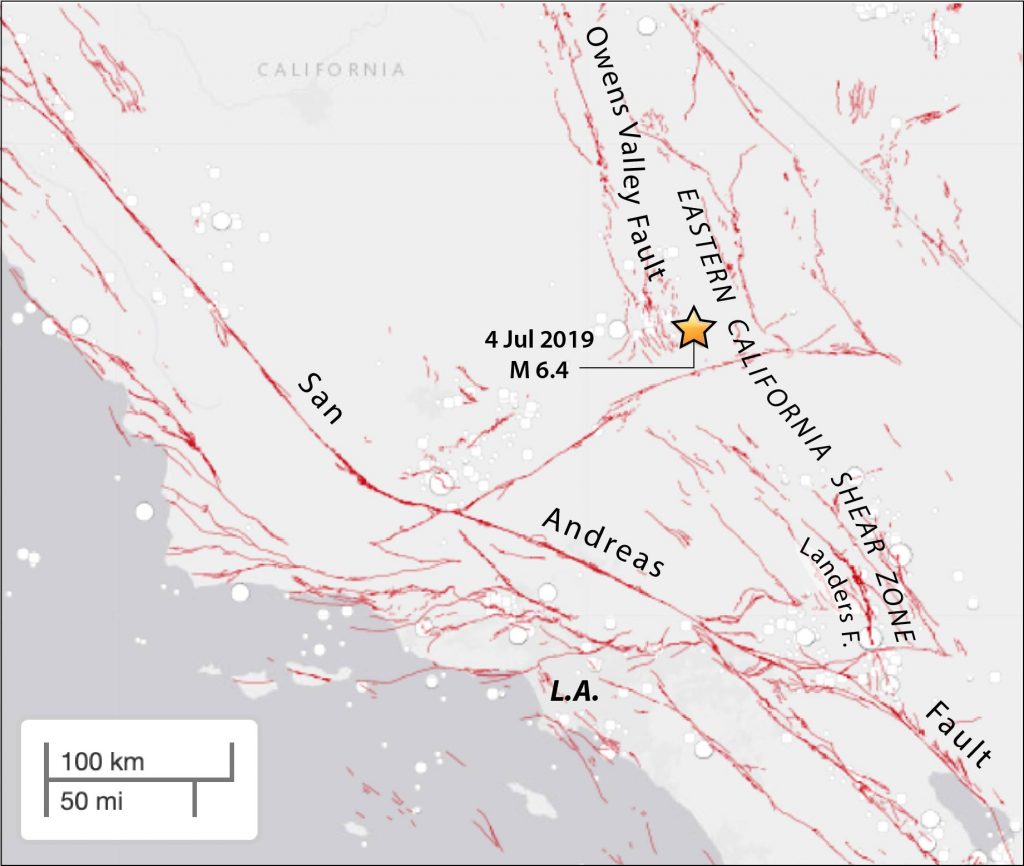Ross S. Stein, Ph.D., and Volkan Sevilgen, M.Sc., Temblor, Inc.
The site of the 4th of July shock was stressed by the great 1872 Owens Valley quake and the 1992 Landers quake. Their overlapping stress lobes may have raised the stakes for this region.
Citation: Stein, R. S., and Sevilgen, V., (2019), Southern California M 6.4 earthquake stressed by two large historic ruptures, Temblor, http://doi.org/10.32858/temblor.034
A Magnitude 6.4 earthquake struck the remote southern California high desert today, a region which has been the site of several moderate earthquakes over the past 30 years (Hauksson and Unruh, 2007), and tends to exhibit swarm-like behavior. Based on its aftershocks, the quake appears to have ruptured two perpendicular faults, one right-lateral (whichever side you are on, the other moves to the right), and the other left lateral, as shown below.

The Eastern California Shear Zone lights up
The quake lies west of Searles Valley and east of Ridgecrest, near the Naval Air Warfare Center on China Lake. This is a region of diffuse shear and extension, as indicated by the myriad of small distributed faults, and is part of the so-called ‘Eastern California Shear Zone.’ It also lies close to a geothermally active region that heats and locally thins the crust. While the San Andreas is the major fault system that accommodates the Pacific-North America plate motion, the Eastern California Shear Zone plays a secondary role, and so, in fact, the plate boundary spans the entire girth of California.

Two quakes gang up in Ridgecrest
We calculate that two large earthquakes, the 26 March 1872 M~7.6 Owens Valley shock, and the 29 June 1992 M=7.3 Landers shock, permanently imparted stress to the site of today’s shock, perhaps increasing the likelihood of earthquakes in this region over others.

The more recent 1992 M 7.3 Landers shock was followed by the Ridgecrest earthquakes of M 5.4 in August 1995, and an M 5.8 in September 1995 (Hauksson et al., 1995). These earthquakes perhaps indicate that stress imparted by the Landers earthquake immediately brought this area closer to failure, and so the 1995 events might be regarded as remote aftershocks.

In 2005, Shinji Toda and his colleagues used the 1992 Landers stress changes and the pattern of seismicity to make a retrospective forecast of seismicity, below. The forecast is in red, the observed quakes that struck are in blue. Because of its voluminous background seismicity and the imparted stress, one can see that the site of the 4th July shock was indeed forecast for a high quake rate.

What’s Next?
Our preliminary calculation, below, suggests that parts of the Garlock, Black Mountain, and Panamint Valley Faults were brought closer to failure by the 4th July quake. Fortunately, all of these are in remote, lightly populated regions.

Citation: Stein, R. S., and Sevilgen, V., (2019), Southern California M 6.4 earthquake stressed by two large historic ruptures, Temblor, http://doi.org/10.32858/temblor.034
References
Egill Hauksson, Kate Hutton, Hiroo Kanamori, Lucile Jones, James Mori, Susan Hough, and Glenn Roquemore (1995), Preliminary Report on the 1995 Ridgecrest Earthquake Sequence in Eastern California, Seismological Research Letters, 66 (6), 54-60, doi.org/10.1785/gssrl.66.6.54
Hauksson, E., and J. Unruh (2007), Regional tectonics of the Coso geothermal area along the intracontinental plate boundary in central eastern California: Three-dimensional Vp and Vp /Vs models, spatial-temporal seismicity patterns, and seismogenic deformation, J. Geophys. Res., 112, B06309, doi:10.1029/2006JB004721.
Stein, R.S., Earthquake Conversations, Scientific American, vol. 288, 72-79, January issue, 2003. Republished in: Our Ever Changing Earth, Scientific American, Special Edition, v. 15 (2), 82-89, 2005.
Toda, S., Stein, R. S., Richards-Dinger, K. & Bozkurt, S. Forecasting the evolution of seismicity in southern California: Animations built on earthquake stress transfer. J. Geophys. Res. 110, B05S16 (2005) https://doi.org/10.1029/2004JB003415
- Earthquake science illuminates landslide behavior - June 13, 2025
- Destruction and Transformation: Lessons learned from the 2015 Gorkha, Nepal, earthquake - April 25, 2025
- Knock, knock, knocking on your door – the Julian earthquake in southern California issues reminder to be prepared - April 24, 2025

